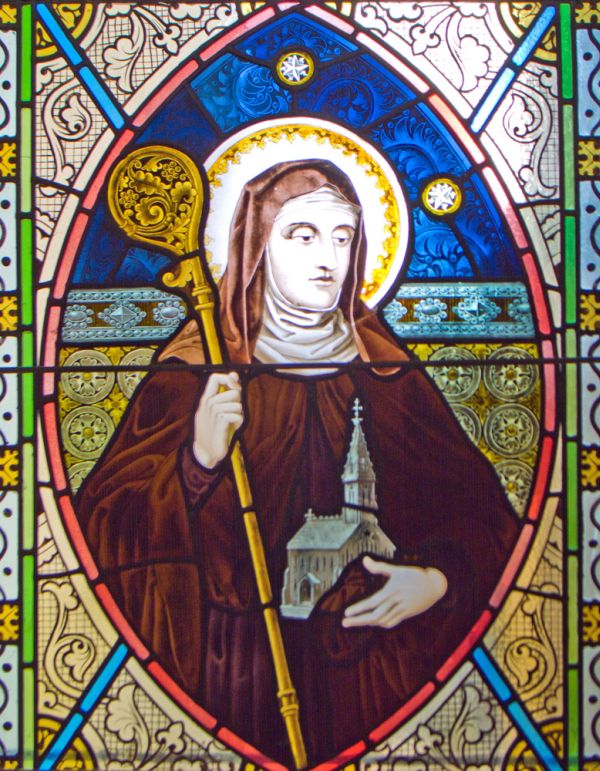Our Building
It is fitting that this museum of local history should be sited in a building itself of great historic interest.
The earliest property used for religious purposes on the Museum site in Alnwick was a house purchased in the late 1750s by the Society of Jesuits, who furnished a room for religious services. Local people who attended Mass there often had to stand in the passageway outside due to lack of space. A new and larger chapel was opened in the same building in 1796. These premises were replaced, on the same site between 1835 and 1836, at a cost of £2,100 by the building seen today.

The window depicting St Hilda, Foundress of Whitby Abbey
In 1855 the Jesuits withdrew, and formally handed over the Parish Church of St Mary to the local Bishop. “A Centenary History” written by parish priest, the Reverend Canon Alfred Chadwick, records the replacing of an oil lamp in the church by gas in 1862, ”The Raffle” to raise funds for the replacement of the existing “very poor quality organ”, and the construction of two altars. The second altar was erected at the expense of the Sisters of Mercy who were living and working in the parish, in memory of the founder of their order.
The church building became redundant when the Diocese of Hexham and Newcastle purchased the larger, also redundant, Anglican church of St Paul in Percy Street which retained its name, but was dedicated in 1982 for use as a Catholic church. Fittings from St Mary’s such as The Stations of the Cross, and the reredos from behind the altar can now be seen in St Paul’s church.
The fabric of this Grade 2 listed building was left largely intact during conversion. A lift was installed to make the museum fully accessible, the basement enlarged to increase storage, and the first floor gallery extended to provide display and working areas. The new mezzanine floor is suspended from the original gallery.
Other original features which can still be seen include the oak roof with its gargoyles and inset stained glass windows, the arch above the site of the altar, and the commemorative stained glass windows on the front façade.
Following the failure of the “Rising of the North” of 1569, the 7th Earl of Northumberland was later beheaded in York for his part in the attempt to restore Catholicism to England. Better known as Blessed Thomas Percy, he is depicted in the window on the west side of the building which was gifted in 1896 by seven of his descendants.
At the same time the window depicting St Hilda, Foundress of Whitby Abbey in AD 657, was installed on the east side. The Percy family had held the Lordship of Whitby prior to their purchase of the Barony of Alnwick in 1309, which explains the connection between the Yorkshire saint and a Northumberland church.
The present organ, the second oldest of its kind in Northumberland, was purchased for the sum of £170 and the first public performance took place in 1865. Later, the addition of an electric blower removed the need for hand operation and the opportunity for the “blowers” to carve their names on the back! The organ has been restored and recitals and the sound of sacred music once again echo in the old building.

